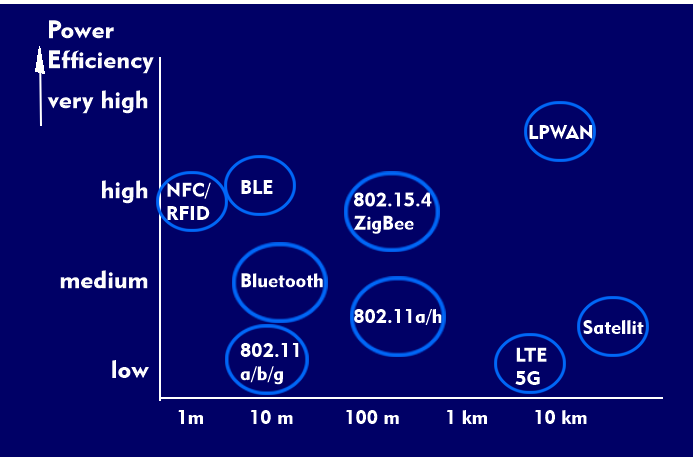low power WAN (LPWAN)
Low Power Wide Area Network (LPWAN), also known as Low Power Network (LPN), are radio networks that cover a large distance range. With their narrow bandwidth, they correspond to the Narrow Band Internet of Things( NB-IoT) and are characterized by high reception sensitivity and low energy consumption.
These characteristics are ideal prerequisites for battery-powered sensors and actuators to ensure many years of battery operation. In addition, unlike well-known radio-based networks such as Bluetooth Low Energy( BLE) or Zigbee, LPWANs cover a wider geographic area. To achieve this, LPWAN networks operate in the sub- GHz range at transmission frequencies of 433 MHz or 868 MHz with lower free- space attenuation than WLANs operating at 2.4 GHz or 5 GHz. Their receive sensitivity is -120 dBm to -130 dBm. In addition, they can be manufactured inexpensively with low-cost chips.
Various standardization bodies have addressed the issue of LPWAN. For example, there is the Low Throughput Network( LTN) proposed by ETSI, the Long Range Wide Area Network( LoRaWAN), Narrow Band LTE( NB-LTE) specified by 3GPP, LTE M2M( LTE-M) and Extended Coverage GSM IoT( EC-GSM-IoT) with cellular structure, SigFox, Dash7, Weightless P, 802.11ah, nWave or Low Power WiFi according to IEEE 802.11ah, WiFI HaLow and the ETSI standardized Mioty, which operate in frequency bands between 433 MHz and 1 GHz. Only Random Phase Multiple Access( RPMA) and Ingenu used the 2.4 GHz range.
The distances that can be bridged depend on the network concept, but range from 5 km to 40 km. As for data throughput, it is low, at a few hundred bits per second (bit/s) or even below. As for latency, this requirement does not arise primarily because applications are sufficiently insensitive to higher latency.
LPWAN network topologies
The Internet of Things (IoT) typically consists of sensors and actuators installed in public places, industrial facilities, or private properties. Therefore, there is a short-range and a long-range area that must be covered in terms of radio technology. As with ZiBee, the short-range area is formed by short-range devices( SRD), which cover the long-range area via gateways.
In the long range connection, the end components are connected via a base station that serves many end components and realizes the connection to servers or a cloud via the access network and the Internet. In the base station, the IoT protocols such as the Constrained Application Protocol( CoAP) or the MQTT protocol are also translated into the application protocols of the end components. Where no direct connection of Bluetooth Low Energy (BLE) or ZigBee can be realized, local gateways between the short-range radio technology and LPWAN are used.


.png)